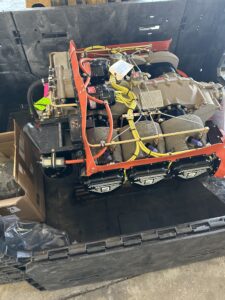They arrived yesterday. 2 fully rebuilt, zero time, Ram/Continental TSIO-520-NB engines. 335 HP at 2450RPM.
Gonna take about two and a half weeks of time to put the accessories on the engines and get them installed. Lot of work for my mechanic dude.
May God give me the strength and patience not to pester the mechanics too much…..
Of course, then I gottta fly it hard and fast (80-85 percent power) for the first 10 hours to break in the rings and such. Gonna be a HUGE fuel bill. But imma go on a long cross country trip. 10 hours at 235 (ish) MPH is a long way….Might stop in and see some people.
I dunno yet. We shall see.
Here is what it looks like sitting in the crate:


LOL! I could never see myself buying an aircraft engine… Let alone TWO!!!
Yeah… Don’t pester the mech too much… It’s an airplane… You don’t want it fast… You want it GOOD!!!
yep.
Good is the word
Is that about 240 pounds per hour ($350) between the two of them?
40 GPH is a bit high in cruise….but about right for 80% running rich of peak.
I gotta read the entire break-in manual to find out what fuel/boost/RPM they want for the break in.
But 240/hour is probably somewhat close.
Do you need for your trip:
Copilot
Navigator
Bombardier
Waist gunner
Ballast
???????
Should have a friend flying with me….but we could find room if you wanna.
Prolly gonna go west then back with a stopover in Minneapolis to a shop I know there that might do some avionics for me at a later date. I have no itinerary yet.
Wouldn’t be cheaper to become a sailplane aviator like me?
First World problems…
What’s yer point?
Way back when, during my racing engine days, we followed the “current directive” of alternating full and near-full throttle with off-throttle compression braking to subject a fresh engine to varying loads for a couple of hours. On a racetrack with straights and corners it was easy, and offered a good way to really, really learn the track, even with somewhat lower corner entry / exit speeds because the plan was make the engine, not the brakes, do most of the deceleration work. The theory was especially subject the piston rings to alternating combustion / coast loading to accelerate lapping them to the cylinder walls for a tighter seal, and give the crystalline structure in the new metallurgy (rods, bearings, pistons, etc) an opportunity to “unwind and settle.”
Aircraft are different, certainly, but internal combustion reciprocating engines are still internal combustion reciprocating engines. Break-in does require loading them fairly heavily, without a good load break-in takes forever, but as for 10 hours at a steady 85%, I’d think varyng the load would have advantages.
Then again, we operated ours at 100% or 5% (and compared to a stock engine our 100% was about 150% of “stock” so there’s that….) without much in between – foot down, foot up – for 1-4 hours at a time (we did run a few 12- and 24-hour races and they stayed together. Usually.) and rebuilt them from the bare block up between races (assuming the block survived; if we sheared a crankshaft it didn’t). And if we did rip apart something important inside the engine we could coast into the grass…….
I figure after all this time the manufacturer know what they are talking about, so I will follow their procedure.
I too have always done what you described in breaking in gas engines (cars). Diesels like to be run hard at or near full load. Ideally pulling a trailer or something like that. But those were always water cooled engines. From what I understand, the air cooled engines need to be run hard to not only seat the rings but also wear in the cylinders. Running less power leads to glazing. Counterintuitive, but that is what I am told.
I will read the manual and follow their instructions.
Don’t know enough to comment on the break in but it sounds like a fun trip!